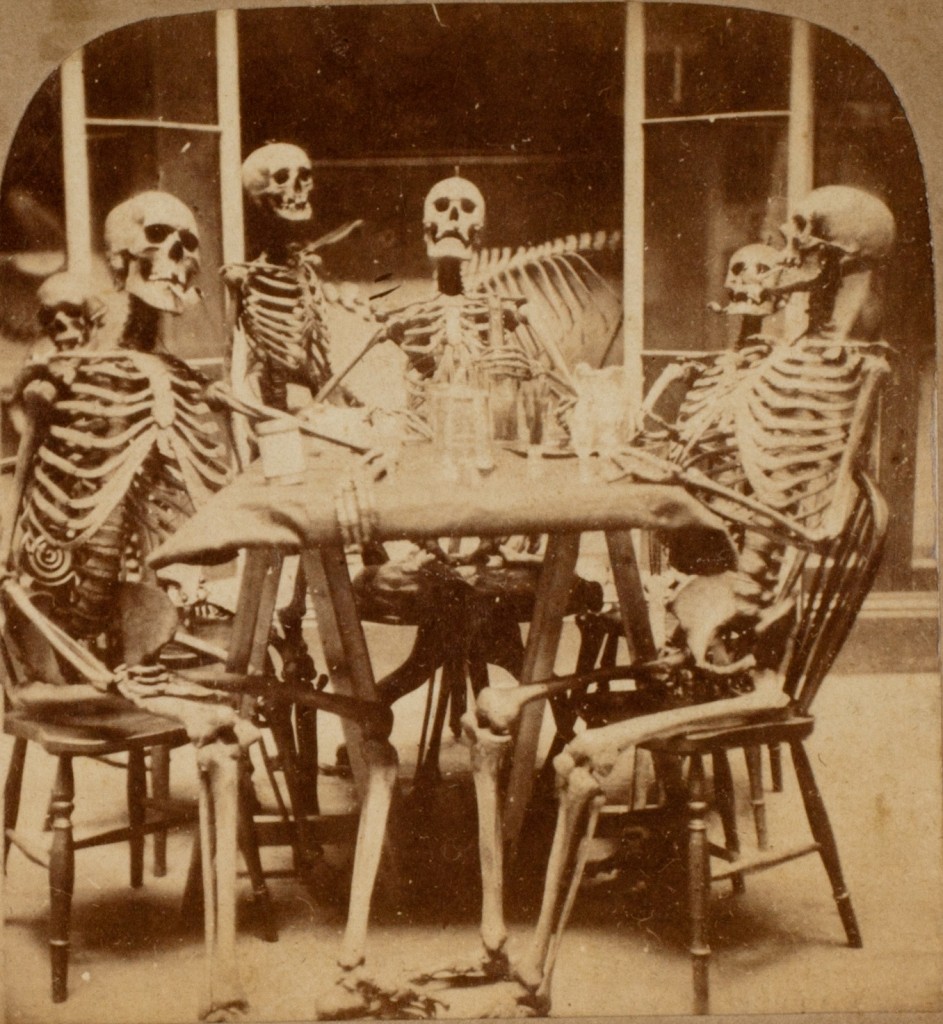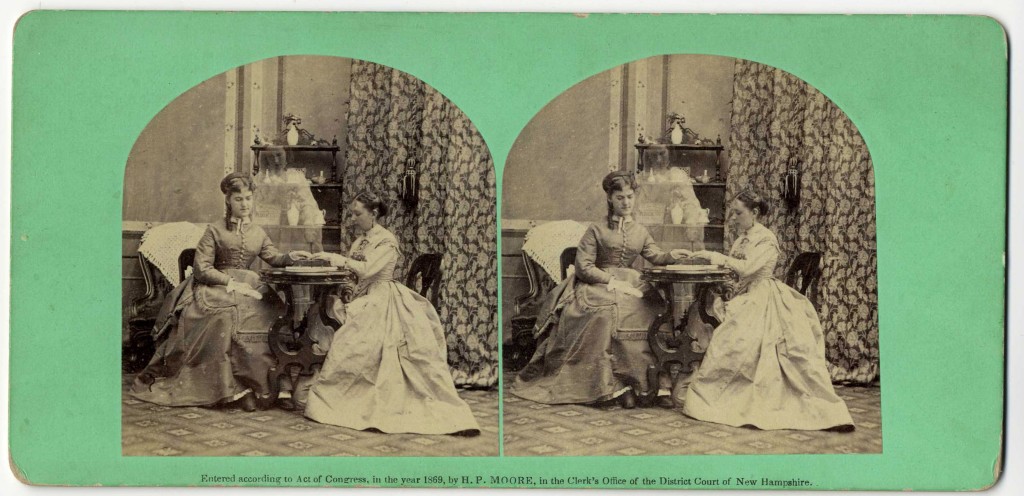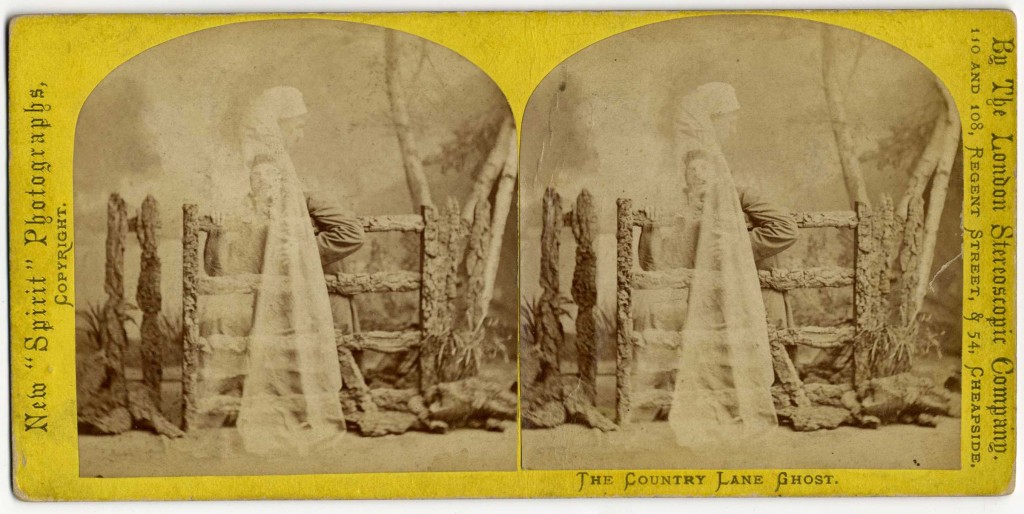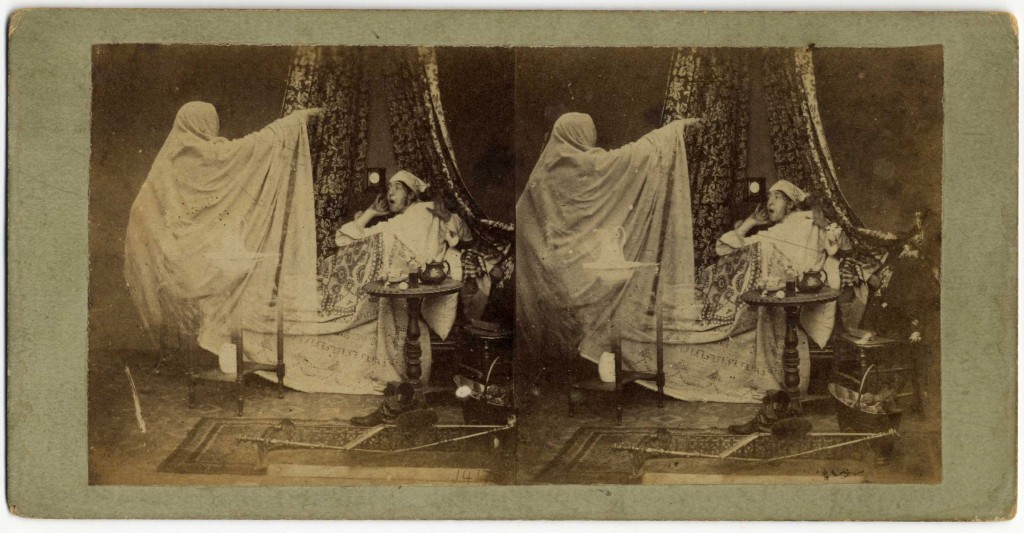 Nothing is hair-raising quite like a chilling photograph.
Nothing is hair-raising quite like a chilling photograph.
This month, when the occult is most heavily sought after in popular culture, we made a small collection accessible which examines death, the afterlife, photography, technology, and (naturally) print culture. AAS’s impressive collection of stereocard views includes a subset categorized as “Ghost” images. This includes approximately 31 images which have been digitized and put into our digital image archive GIGI. In this group are such strange occurrences as an assemblage of skeletons arranged by an anatomist and recreations of literary pieces such as Lord Byron’s Gothic work Manfred and Tennyson’s May Queen. This set of views also features examples of “spirit photography,” which Nancy West defines in her essay “Camera Fiends: Early Photography, Death, and the Supernatural” as “the practice of taking photographs in order to produce visual evidence of ghosts, spirits, and other supernatural elements” (1).
While at first glance many of these images do not appear to be the type of spirit photography of the sinister variety (which offered claims to customers that portraits could be taken with deceased friends or family members), they still represent a striking group. The more predatory practice is described in depth by P.T. Barnum in 1866 in a chapter titled “Spiritual Photographing” in his text Humbugs of the World: An Account of Humbugs, Delusions, Impositions, Quackeries, Deceits, and Deceivers, in All Ages. He blames the success of the such practices, in part, on “the extreme gullibility of the human race.” The photographs at the Society, however, instead seem to belong to a range of experimentation with long exposures and staged scenes. In the spirit of Halloween we thought it would be a treat to showcase these items which are paradoxically dark and playful, blend realism with humor, and for the nineteenth-century viewer likely produced a combination of fright and delight. The deliberate creating of spirit images can be done at any stage of photography, says Fred Gettings in his Ghosts in Photographs, “from the preparation of such images on the background behind a sitter with special chemicals invisible to ordinary vision, but recorded on the film, to the mere conjuring trick of the substitution of pre-photographed images to the most common – the double exposure” (2). Below are just a few of our favorites which make use of these techniques of design.
In this view below titled “A Ghostly Visitation,” a startled young woman pulls back, knocking over a chair, her hand towards her mouth; she is looking towards a hooded ghost before the bench of an upright piano. This view titled “The Planchette” (which centers on an entertainment of the same name) features two women conducting a séance seated at a table with eyes closed holding the device while the ghost of a third woman (seen standing) guides the writing implement. The box for the Planchette can be seen through the ethereal figure on the shelf behind her. This 1869 image by H.P. Moore creates visual evidence of a rare opportunity to see how the Planchette is operated by the otherworld – and how “communication” is directed.
This view titled “The Planchette” (which centers on an entertainment of the same name) features two women conducting a séance seated at a table with eyes closed holding the device while the ghost of a third woman (seen standing) guides the writing implement. The box for the Planchette can be seen through the ethereal figure on the shelf behind her. This 1869 image by H.P. Moore creates visual evidence of a rare opportunity to see how the Planchette is operated by the otherworld – and how “communication” is directed.
 “The Country Lane Ghost” by New “Spirit Photographs” of London Stereoscopic Company, takes the spirit outside in this view, which shows a hooded figure walking down a road in a countryside. The man, crouching behind a worn fence, is visibly stunned and the fear on his face is visible through the exterior of the strolling ghost.
“The Country Lane Ghost” by New “Spirit Photographs” of London Stereoscopic Company, takes the spirit outside in this view, which shows a hooded figure walking down a road in a countryside. The man, crouching behind a worn fence, is visibly stunned and the fear on his face is visible through the exterior of the strolling ghost.
 The final image we show here is inside, in a bedroom to be precise, where a man (in nightclothes and cap) is awoken by a ghost with an outstretched arm. The bed is beside a table with pitcher, teakettle, cup, saucer, and bottle, which may suggest other means for bringing on this spiritual visit.
The final image we show here is inside, in a bedroom to be precise, where a man (in nightclothes and cap) is awoken by a ghost with an outstretched arm. The bed is beside a table with pitcher, teakettle, cup, saucer, and bottle, which may suggest other means for bringing on this spiritual visit.
 What strikes me about these images is how the figures are staged – two with the living person literally boxed in by the apparition (on the left), one with the apparition in the center back suggesting the guiding hand of a creature from another world, and a final one with the apparition in the center front (who might actually “pop” towards the viewer when the stereocard is seen through a viewfinder). It’s also interesting how these images place the ghost figure in front of items to enhance their transparency and highlight the skill of the photographer. By looking at these images, the figures are invited not only into the world of the living, but into the intimate world of the viewfinder.
What strikes me about these images is how the figures are staged – two with the living person literally boxed in by the apparition (on the left), one with the apparition in the center back suggesting the guiding hand of a creature from another world, and a final one with the apparition in the center front (who might actually “pop” towards the viewer when the stereocard is seen through a viewfinder). It’s also interesting how these images place the ghost figure in front of items to enhance their transparency and highlight the skill of the photographer. By looking at these images, the figures are invited not only into the world of the living, but into the intimate world of the viewfinder.
If you’re seeking some examples of stereocards with specter, give up the ghost and peruse these views!
Notes:
- Nancy West, “Camera Fiends: Early Photography, Death, and the Supernatural,” CR: The Centennial Review vol. 40, no. 1 (1996): 170-206.
- Fred Gettings, Ghosts in Photographs: The Extraordinary Story of Spirit Photography (New York: Harmony Books, 1978), 144.

I really love these old examples of photography. I stumbled across these while looking for double exposures, you can see how much we have evolved. Yet, we draw so much from these old images!